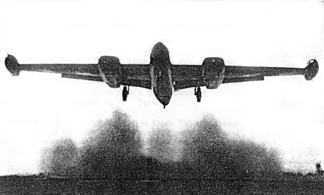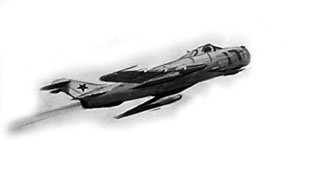Midnight Mission
|
|||||||||||||||||
|
Photos from the author’s collection and Warren M. Bodie Page 3 of 7 Pages |
|||||||||||||||||
| Every pilot knows the value of a steady natural horizon, without a kaleidoscope of dancing lights to distract him. It took a high degree of skill on the part of the B-52 pilot to keep his equilibrium senses from creating havoc trying to maintain a steady platform for the boom operator, while flying a very tight trail formation a few feet astern of the tanker.
The similarity in this situation, with searchlight beams dancing around in all directions, bouncing off the RB-45 canopy, hitting the nacelles, ricocheting off the windshield and generally causing disorientation, is closely akin to the sensation experienced with northern lights in the high polar regions. The best rule to follow in such a situation is to apply the long established pilots axiom: "Go on instruments and forget about your human senses, no matter what they tell you." This was impossible to do when flying formations, but was the answer when flying single-ship recon missions. The ultimate conclusions of these tests, and several to follow with an all black painted RB-45C, showed that it was very simple to track an unpainted B-45 flying at high altitude with a manual searchlight. With radar-operated searchlights, the problem for the ground operators was much simpler. On the other hand, an all black painted B-45 was determined to be much more difficult to track, but not impossible. In fact, after several passes at the same altitudes as the non-painted B-45, ground searchlight operators were unsuccessful in manual and radar operations in establishing a reliable track on the aircraft for accurate antiaircraft lock-on. |
|||||||||||||||||
| Painting the aircraft had been the conclusion of the theoretical discussions. However, a B-45 had never been fully painted before. We were not certain of the detrimental effect of the paint on airspeed loss and flying characteristics. We reasonably concluded it would be minimal, which later proved to be the case. The loss in airspeed was about 8 to 10 knots. |
|||||||||||||||||
 |
|||||||||||||||||
| We decided that painting at least one of our B-45s was the way to go. The questionable factor of North Korea proficiency and equipment difference between our searchlight crews and theirs was unknown up to the mission we were now about to launch |
|||||||||||||||||
| Tower - Raven One-1 (our call sign) ready for takeoff.
Roger Raven One-1, winds 320, 15 knots, cleared as filed, contact Oak Hill Able coasting out, squawk IFF 2-2. Roger tower - Raven 1 releasing brakes, on the roll. Nose gear steering engaged - on centerline - 50 kts., looks good. Coming up on 110 kts., committed - steady, little crosswind. 160 kts. - ease it off, gear up, trim for climb. |
 |
||||||||||||||||
|
Yokota Air Base, Japan Photo Ctsy. Robert F. Dorr |
|||||||||||||||||
| Climb to 500 feet, continue acceleration to 180 kts., ease flaps up. Looks clean - back off on the power to 98% rpm, EGT, fuel pressure, oil pressure good, start transfer from 1200 gallon tip tanks - copilot making radio contact - starting acceleration to 400 knots - commencing cruise climb to 35,000 feet assigned altitude.
Radar Nav reports radar equipment functioning OK, all cameras - checked - OK. |
|||||||||||||||||
 |
|||||||||||||||||
|
|
|||||||||||||||||
| All systems checked - after takeoff and climb check list completed - entering cloud deck 1500 feet, going on instruments, can expect some icing.
Coasting out in 8 minutes over the Sea of Japan on NW heading, check Mae West. Water is 31 degrees down there, it not the drowning that gets you, it’s the freezing in 5 minutes after you hit the drink! Last radio check coming up - now radio silence -arm tail turret guns, running lights off, dim cockpit lights, double check - IFF. Leveling off at 35,000 feet, in the clouds, some turbulence. Check cabin oxygen to combat position, tip tanks feeding OK, some roughness in #4 engine. Entering 7th Fleet waters, squawk IFF mode 4-1 as briefed. RN reports he can see Navy Task Force 77 up ahead: Don't want to tangle with them! Coasting in at Wonsan Harbor, 2 minutes, in and out of clouds, heavy fires in the harbor from last night’s B-29 raid. Can clearly see the main battle line and artillery fire below and to the south, stretching across the entire peninsula from east to west. Continuing on heading, target time 20 minutes to go. All visual and radar cameras set, following Radar Navigator’s instructions on headings and evasive action. There it is - just beyond the nose, breaking out of the clouds now, primary target open for visual photography, but that allows searchlights to spot us - maybe. Copilot reports we are picking up light contrails, no sign of fighters - yet. Now for the test - there they are up ahead - searchlights sweeping the sky. Have they detected us? Must know we are coming. Passing the IP (initial point prior to target) - 15 miles to target - can’t turn now, following PDI (Pilot's Direction Indicator) as per RN's (Radar Navitagor's) directions. Two searchlights just picked us up, but they can’t seem to keep us in their beam, whipping through rapidly, now back on us. Reflection not as bad as with our 800,000,000 units back at home base. They know we're here! And here it comes, ack ack! It's below us but heavy, 30 seconds to the target, steady. Searchlights can't seem to lock on - black paint must be working - good ol' zinc chromide and black lacquer. Over target, RN collecting radar and infrared data, as required, plus good visual pictures for intelligence briefing for the bomber stream to follow later. "Clear to turn?" I ask the RN. "Right, going to 110 degrees" - 90 degrees banking turn to left. As I turn, I can spot over my left shoulder, looking almost directly below us, an airfield with traces of jet flames on the runway. Those are MiGs heading up to greet us. |
|||||||||||||||||
 |
|||||||||||||||||
 |
|||||||||||||||||
 |
|||||||||||||||||
 |
|||||||||||||||||
| Now to make a run for the coast. With these 90 kt. westerly tail winds, we should make it quickly.
Both the 5th Air Force Tactical Air Control Center (TACC) and the Navy have been alerted to our presence. Let's hope we hear from some F-86s, or at least from F9F Cougars on our way back to the coast. Now #4 is vibrating badly, oil pressure fluctuating, down to 5 psi. EGT exceeding red line even at idle RPM. Better cut it back - trim - still vibrating - throttle back, completely shut it down - why take a chance? "Roger Oscar Sierra 6, understand off from K-14 with a flight of four heading our way; keep it coming. We saw MiGs take off below us three minutes ago. I think they have us under surveillance. We may need your help." (Flight of four F-86s coming up from Kimpo to escort us.) Radio silence now broken. Author’s note: An essential aspect of aerial reconnaissance is to avoid detection at all cost. As a result, recon aircraft are seldom, if ever, escorted over their target by fighter cover. To do so would simply make a larger return on the opponent's radar. Therefore, if escort is provided at all, it occurs in the pre-and post-target phase: One, to ensure that the recon aircraft get to the target area, and two, to ensure safe return with vital cargo of film and other intelligence data. Page 1, Page 2, Page 3, Page 4, Page 5, Page 6, Page 7 To Go To — RB-45 Home — or — Miscellaneous RB-45 Home - Contact Us - Cold War Hist. - 91st SRS Hist. - Stardust 40 Mission Story |
|||||||||||||||||